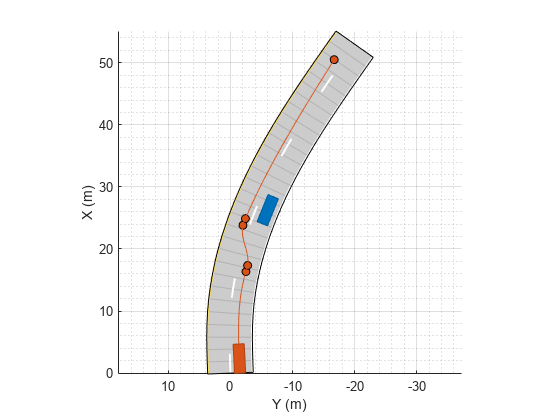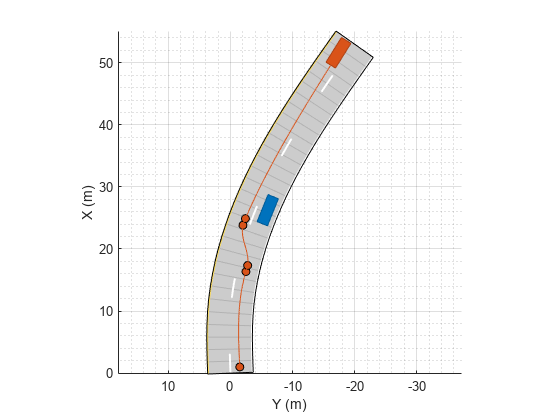record
Run driving scenario and record actor states
Syntax
Description
Examples
Create a driving scenario in which one car passes a stationary car on a two-lane road.
scenario = drivingScenario; road(scenario,[0 0; 10 0; 53 -20],'lanes',lanespec(2)); plot(scenario,'Waypoints','on'); stationaryCar = vehicle(scenario,'ClassID',1,'Position',[25 -5.5 0],'Yaw',-22); passingCar = vehicle(scenario,'ClassID',1); waypoints = [1 -1.5; 16.36 -2.5; 17.35 -2.765; ... 23.83 -2.01; 24.9 -2.4; 50.5 -16.7]; speed = 15; % m/s smoothTrajectory(passingCar,waypoints,speed);

Record the driving scenario simulation.
rec = record(scenario);

Compare the recorded poses of the passing car at the start and end of the simulation.
rec(1).ActorPoses(2)
ans = struct with fields:
ActorID: 2
Position: [1 -1.5000 0]
Velocity: [14.9816 0.7423 0]
Roll: 0
Pitch: 0
Yaw: 2.8367
AngularVelocity: [0 0 1.2537e-05]
rec(end).ActorPoses(2)
ans = struct with fields:
ActorID: 2
Position: [50.4717 -16.6823 0]
Velocity: [12.7171 -7.9546 0]
Roll: 0
Pitch: 0
Yaw: -32.0261
AngularVelocity: [0 0 -0.0099]
Input Arguments
Driving scenario, specified as a drivingScenario object.
Output Arguments
Recording of actor states during simulation, returned as an M-by-1 vector of structures. M is the number of time steps in the simulation. Each structure corresponds to a simulation time step.
The rec structure has these fields:
| Field | Description | Type |
|---|---|---|
SimulationTime | Simulation time at each time step | Real scalar |
ActorPoses | Actor poses in scenario coordinates | N-by-1 vector of
ActorPoses structures, where
N is the number of actors,
including vehicles. |
Each ActorPoses structure has these fields.
| Field | Description |
|---|---|
ActorID | Scenario-defined actor identifier, specified as a positive integer. |
In R2024b:
| Front-axle position of the vehicle, specified as a three-element row vector in the form [x y z]. Units are in meters. Note If the driving scenario does not contain a
front-axle trajectory for at least one vehicle,
then the
|
Position | Position of actor, specified as a real-valued vector of the form [x y z]. Units are in meters. |
Velocity | Velocity (v) of actor in the x- y-, and z-directions, specified as a real-valued vector of the form [vx vy vz]. Units are in meters per second. |
Roll | Roll angle of actor, specified as a real-valued scalar. Units are in degrees. |
Pitch | Pitch angle of actor, specified as a real-valued scalar. Units are in degrees. |
Yaw | Yaw angle of actor, specified as a real-valued scalar. Units are in degrees. |
AngularVelocity | Angular velocity (ω) of actor in the x-, y-, and z-directions, specified as a real-valued vector of the form [ωx ωy ωz]. Units are in degrees per second. |
For full definitions of these structure fields, see the actor and vehicle functions.
Data Types: struct
Version History
Introduced in R2017aIf a driving scenario contains a front-axle trajectory for at least one vehicle,
the ActorPoses structure in the output rec
structure now returns the front-axle position in the form [x
y
z] for vehicles specified with front-axle steering.
MATLAB Command
You clicked a link that corresponds to this MATLAB command:
Run the command by entering it in the MATLAB Command Window. Web browsers do not support MATLAB commands.
选择网站
选择网站以获取翻译的可用内容,以及查看当地活动和优惠。根据您的位置,我们建议您选择:。
您也可以从以下列表中选择网站:
如何获得最佳网站性能
选择中国网站(中文或英文)以获得最佳网站性能。其他 MathWorks 国家/地区网站并未针对您所在位置的访问进行优化。
美洲
- América Latina (Español)
- Canada (English)
- United States (English)
欧洲
- Belgium (English)
- Denmark (English)
- Deutschland (Deutsch)
- España (Español)
- Finland (English)
- France (Français)
- Ireland (English)
- Italia (Italiano)
- Luxembourg (English)
- Netherlands (English)
- Norway (English)
- Österreich (Deutsch)
- Portugal (English)
- Sweden (English)
- Switzerland
- United Kingdom (English)